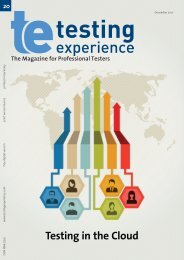Agile Performance Testing - Testing Experience
Agile Performance Testing - Testing Experience
Agile Performance Testing - Testing Experience
Create successful ePaper yourself
Turn your PDF publications into a flip-book with our unique Google optimized e-Paper software.
Database Constraints restrict which data can be stored in the tables of a<br />
database. There are the following constraints: Unique constraints state<br />
that this attribute must be different for all rows of a table. ID columns<br />
are a good example. Primary key constraints allow identifying a row.<br />
They can span more than one attribute. Foreign keys refer to primary<br />
keys of a different table. They ensure that there is a fitting value in the<br />
different table, e.g. a financial statement refers always to an existing<br />
(!) customer ID in the customers table. Not null constraints demand<br />
that there is a value provided for this attribute, e.g. that all financial<br />
statement have a sum of assets or a sum of liabilities. Check constraints<br />
allows formulating nearly arbitrary conditions.<br />
tion compliance. Application compliance means that the DBAP input state<br />
could be the result of “normal” GUI input and data processing. Statement<br />
(4) is a perfect example. Now no false positives can appear. But still, test data<br />
can be better. Let us assume a test case shall test the credit rating functionality<br />
for large corporations with assets and liabilities of more than 1’000’000.<br />
We are interested whether procedure P_CALC_RATINGS considers specific<br />
risks of large companies. This test case requires a financial statement with<br />
“higher” values such as statement (5).<br />
(5) INSERT T_ FINSTATEMENTS(OWNER_ID, SUM_AS, SUM_LI)<br />
VALUES (32, 1’500’000, 1’500’000);<br />
The difference between statements (4) and (5) is that the latter allows us<br />
to test the execution path (or test case) we are interested in: the credit rating<br />
for large corporations. If the DBAP test data is suitable for a test case,<br />
it is path-compliant (the term refers to the path coverage criterion). Path<br />
compliance bases always on a test case and a specific execution path of the<br />
application. This is the highest level we can achieve. However, it also makes<br />
clear that different test cases might need different test data sets. Figure 5<br />
compiles the information about all four compliance levels.<br />
Figure 6: Overview Compliance Levels<br />
In this article, we explained the typical problems of testing database-driven<br />
applications. Instead of providing simple answers to complex problems, we<br />
concentrated on explaining the different challenges for projects. Our goal is<br />
to foster discussions within projects to find the best solutions for their particular<br />
problems. Thus, we explained the most important concepts: the test<br />
data cube, correctness, test cases, and quality for DBAPs.<br />
www.testingexperience.com<br />
Biography<br />
Klaus Haller is a Senior Consultant with<br />
COMIT, a subsidiary of Swisscom IT<br />
Servies. COMIT focuses on projects and<br />
application management services for<br />
the financial industries. Klaus’ interest<br />
is the architecture and management of<br />
information systems. His experiences<br />
span from process engineering, architecture<br />
and implementation of data<br />
migration solutions for core-banking<br />
systems to the responsibility for the<br />
database backend of a credit rating<br />
application. Klaus studied computer<br />
science at the Technical University of<br />
Kaiserslautern, Germany. He received<br />
his Ph.D. in databases from the Swiss<br />
Federal Institute of Technology (ETH) in<br />
Zurich, Switzerland. He welcomes your<br />
feedback at klaus.haller@comit.ch<br />
The Magazine for Professional Testers<br />
19









